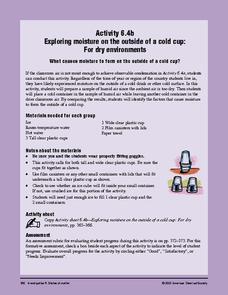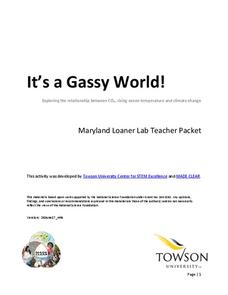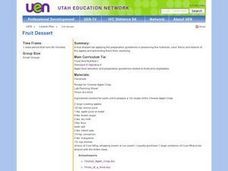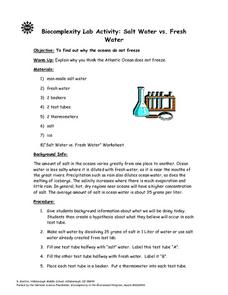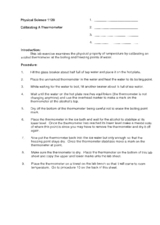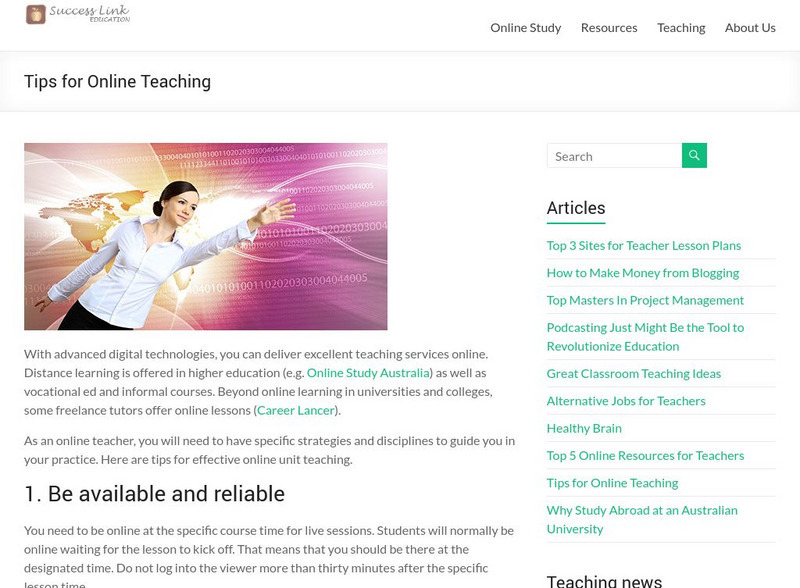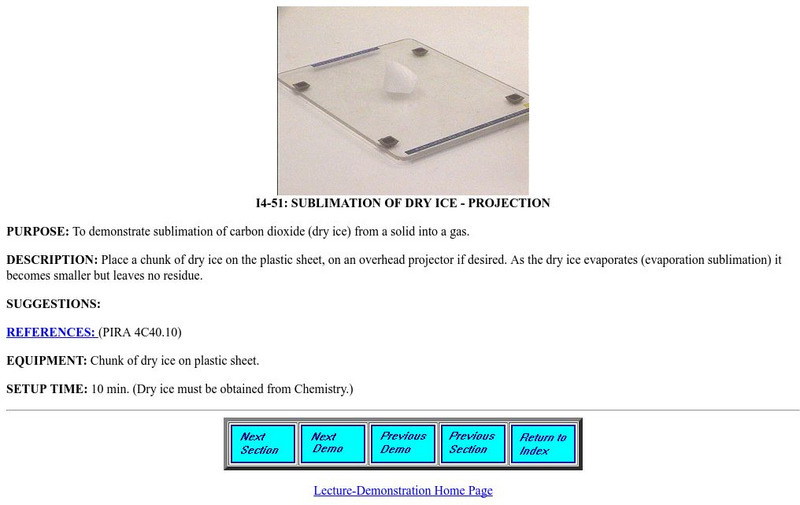Curated OER
Dry Ice Activities Mini Lesson
Get your middle schoolers experimenting with dry ice. In the first activity, they place a piece in water and then use phenol red to identify its pH. In the second, they place a piece in a limewater solution and watch as the combination...
American Chemical Society
Exploring Moisture on the Outside of a Cold Cup: For Dry Environments
If the area you live in is arid, or the preceding experiment in this unit didn't yield obvious results, use this one in place of it to help reveal where condensation comes from. The mini unit that this is part of a comprehensive...
Curated OER
Wet Dry Ice Lab
In this wet dry ice instructional activity, students read the information about dry ice and phase change. Students perform an experiment in which they observe phase changes of ice. Students answer analysis questions as it relates to the...
American Chemical Society
Exploring Moisture on the Outside of a Cold Cup
As a stand-alone or as part of the intended unit, this is a valid investigation of what causes condensation to occur. By limiting the amount of air around a cold cup of water and comparing it to one out in the open, they find that...
Towson University
It's a Gassy World!
How much does your class know about the relationship between climate change and carbon dioxide? Science scholars explore the nature of greenhouse gases and rising ocean temperature through demonstrations, research, and experiments. The...
Curated OER
Wet-Dry Bulb Hygrometers: Measuring Relative Humidity and Apparent Temperature
Young scholars work in groups of 4 for the activity/activity part of this exercise. They know that clouds are formed by the condensation of water vapor, affect weather and climate. Also that global patterns of atmospheric movement...
Curated OER
Life in Extreme Environments - Lakes Under Ice
Students collect chemical, physical, and biological data from a local lake throughout the year. In addition, students discuss the design of an experimental structure for water collection at several specific depths as well as assess the...
Curated OER
Cave Painting in the Ice Age
Students take notes and sketch during the Internet research. They take notes of the colors found in the cave paintings (black, browns, ochre, sienna). They create an initial full size comprehensive sketch on scrap paper and in their...
Curated OER
Fruit Dessert
Third graders complete a fruit lab applying the preparation guidelines in preserving the nutrients, color, flavor and texture of the apples and preventing them from oxidizing.
Curated OER
States of Matter Lessons
Teachers can give their students hands-on ways to explore solids, liquids, and gases with these lesson plans.
Curated OER
Carbon Dioxide
High schoolers conduct a series of experiments to explore carbon dioxide properties. In this chemistry lesson, students explain the production and uses of this gas. They measure its amount in soda and waste product of yeast.
Curated OER
Bridges for All: Better Way
Students explore organizations founded for the common good. In this character education lesson, students read about organizations that developed for the common good during the Civil War and Reconstruction. In small groups, students...
Curated OER
A Better Way
Students increase awareness of organizations that grew out of necessity and increased social consciousness during the Civil War and Reconstruction. They trace the origins of three organizations founded for the common good. They link...
Curated OER
DNA Isolation from Plant Tissue
High schoolers perform an experiment to extract and observe DNA from plant Tissue. They read about the procedure and relate it to the procedure used to isolate DNA from an endangered plant species. This is instructional activity three...
Curated OER
Matter and Energy
Middle schoolers participate in a small group read aloud of the short story, "Cerium" by Primo Levi. They answer several questions about the story and then relate the reading to a lecture on Kinetic theory. After the lecture they apply...
Curated OER
Salt Water vs. Fresh Water
Students explore why the oceans do not freeze. They explain why they think the Atlantic Ocean does not freeze. Students are given background information about what they are doing. They create a hypothesis about what they believe...
Curated OER
Making Layered Hail Stones
Young scholars explore how hail forms in the atmosphere, why hailstones are layered, and what accretion is. They also learn what supercooled liquids are.
Curated OER
Wacky Water Critters
Students visit a local creek or stream. They collect water samples from the creek and observe and sort the "water critters" they find in the sample, observing smaller organisms under a microscope if necessary. They identify each organism...
Curated OER
Calibrating a Thermometer
Students calibrate an alcohol thermometer using the boiling and freezing point of water. In this physical science lesson, students explain what happens to boiling point of water as altitude increases. They calculate their experimental...
Curated OER
Condensation
Students explain how water changes from vapor to liquid with a change in temperature by engaging in this experiment. They use a worksheet imbedded in this instructional activity to guide their inquiry.
Success Link
Success Link: Dry Ice Lab/demonstration How Cool It Is!
A lesson plan using dry ice to show the four states of matter. Included are inquiry-based questions to use as part of the demonstration.
Science Bob Pflugfelder
Science Bob: The Giant Dry Ice Bubble Sphere
Science Bob presents instructions for making a giant dry ice bubble sphere using common supplies.
University of Maryland
Univ. Of Maryland: Sublimation of Dry Ice Projection
A short page from the University of Maryland Physics Lecture Demonstration Facility. Provides directions for a teacher demonstration on sublimation. Shows apparatus and set-up; provides suggestions. Easily adaptable as a student project...

